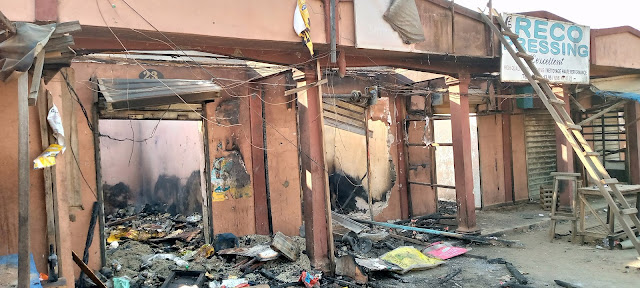On Wednesday evening, December 8, soldiers in Cameroon’s Northwest regional capital, Bamenda conducted an operation that ended with scores of houses and businesses burnt down and several people killed.
According to video evidence and testimony of some witnesses, several persons were killed in the operation – some burnt alive. The locals have blamed state security officers for the killings and burnings.
In a communique released on Friday, December 10, 2021, the Ministry of Defence confirmed the operation. It stated that at about 3 PM on December 8, a convoy of the BIR was immobilised in the Bamenda-Mbengwi stretch of road, using wired Improvised Explosive Devices, IED.
The operation, going by local sources and even the Ministry of Defence, MINDEF press statement, was a retaliatory one by the military who set out to avenge a separatist attack on a BIR. “With the use of a wire-controlled improvised explosive device, IED, the insurgents immobilised the convoy of the Defence and Security Forces, before opening heavy fire on the latter,” MINDEF said in a statement.
The aftermath of the operation rather depicted an attack on the locals and not the separatists as supposed by the MINDEF statement. Locals testify that in rage, the backup troops descended on locals and their properties, burning and shooting indiscriminately. What caught the attention of many, was the widespread burnings that left several structures destroyed.
In several videos making rounds on social media, several houses, businesses and even dead bodies are seen, as a result of the fire and shootings. The locals testified that the burning and killings were orchestrated by the rampaging soldiers. Early media reports put the number of those burnt alive at five. Statistics provided from locals in the area say at least six persons were killed and several others shot and wounded.
Panoramic amateurish videos taken by some of the victims from hiding spots shows wide sections of the targeted neighbourhoods with its structures going up in flames.
In the Ministry of Defence’s Statement, Navy Captain Cyrille Atonfack in his press release said local military units in the areas were deployed as a backup to secure the area where the BIR convoy was immobilised. However, what those on the ground witnessed was an invasion of their homes, shootings, and burning of houses which forced many to flee their homes.
The MINDEF statement claimed that the only fire incident was recorded during a gunfire exchange during which a warehouse of explosive devices was ignited. The statement said the fire spread to nearby houses. On the contrary, the fire incidents were recorded at Mbengwi Road, Azire, Hospital Roundabout and Rendezvous neighbourhoods. The videos taken by locals show several houses on fire, and it was not only in a single location as claimed by MINDEF. MINDEF claims that those who died during the retaliatory attack were four separatists, but video evidence shows at least two apprentices at a metal workshop killed and partially burnt during the operation. The two were identified by locals who said they were young children. At that scene, there was a third survivor with a bullet in his leg.
Satellite imagery of the concerned neighbourhood showed that the fire was not in a single location too. In a statement released after investigations, the Centre for Human Rights and Democracy in Africa, CHRDA and Cameroon Anglophone Crisis Database of Atrocities said the burnings were deliberate.
“The scale and distribution of burned buildings, plus the distance between these burned sites, demonstrate that this incident was a deliberate burning of the community rounding Mbengwi Road by the state security forces,” they said.
The action of state troops contravenes Article. 8 (2) (a) (iv) of Rome Statute of the International Criminal Court which spells out what constitutes a war crime. Here it defines it to include “Extensive destruction and appropriation of property, not justified by military necessity and carried out unlawfully and wantonly.”
Also, Article 85 (3) (a), plus art. 51(2) of the Protocol Additional to the Geneva Conventions of 12 August 1949, and relating to the Protection of Victims of International Armed Conflicts (Protocol I), 8 June 1977 also states that “Intentionally launching an attack in the knowledge that such attack will cause incidental loss of life or injury to civilians or damage to civilian objects or widespread, long-term and severe damage to the natural environment which would be clearly excessive in relation to the concrete and direct overall military advantage anticipated” is an act that shall amount as a war crime. In article 3, the Universal Declaration of Human Rights states that everyone has the right to life, liberty and the security of person. In the Mbengwi Road incident, the soldiers whose responsibility is to protect citizens were rather seen tormenting and killing some, abridging their right to life. The incident has received wide condemnation, with critics saying that such blanket actions rather fuel the conflict and drive many who are readily recruited by separatists to fight against government troops.
By Andrew Nsoseka

